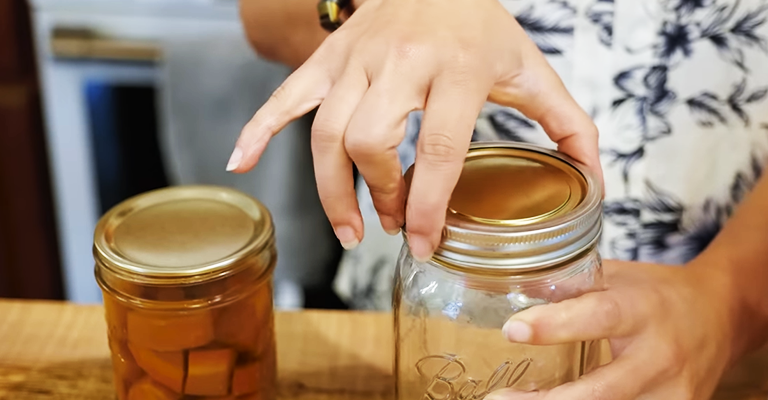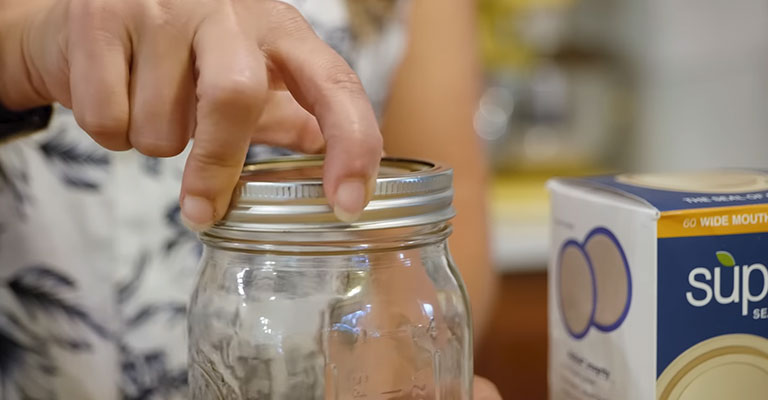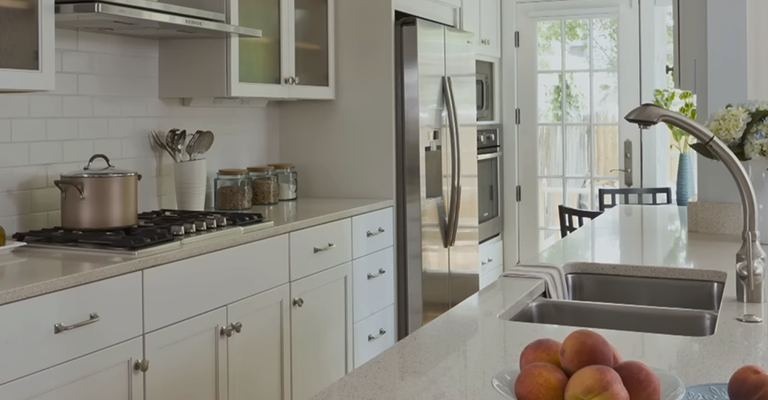Why Did My Canning Lids Buckle?-Unraveling the Mystery
Canning is a time-honored method of preserving the bounty of nature, allowing us to savor the flavors of summer well into the depths of winter.
However, those who engage in home canning may encounter a vexing issue: the buckling of canning lids.
This occurrence, where the once-flat lids take on distorted shapes, can thwart the efforts to create a secure and airtight seal, potentially compromising the safety and longevity of preserved foods. Understanding why canning lids buckle is essential for any home canner.
In this exploration, we delve into the common causes and solutions behind this phenomenon, providing the knowledge necessary to ensure successful and satisfying home canning experiences.

What is Canning Lid Buckling?
Canning lid buckling refers to the deformation or warping of the metal lids used in home canning processes. It occurs when the lid’s surface takes on a concave or convex shape, deviating from its original flat form.
This distortion is often a result of factors like incorrect jar size, over-tightening of screw bands, prolonged preheating, or exposure to extreme temperatures.
Damaged or aged lids, improper storage conditions, and inadequate cleaning of jar rims can also contribute to this issue.
When lids buckle, they may fail to create a proper seal, compromising the safety and quality of preserved foods. It’s crucial to address the underlying causes to ensure successful canning outcomes.
Why Did My Canning Lids Buckle?
Canning lids can buckle or become distorted for several reasons. Understanding these factors is crucial for successful home canning.
Here are some of the common reasons why canning lids may buckle:
Incorrect Jar Size
Using the wrong jar size is a common mistake. Canning lids are designed to fit specific jar sizes, so mismatching them can result in imperfect sealing. Always ensure that your lids correspond to the size of the jars you are using.
Over-tightening
When sealing jars, it’s important not to overtighten the screw bands.
Over-tightening can cause excessive pressure within the jar, leading to lid distortion and even failed seals. Follow the manufacturer’s guidelines for proper lid tightening.
Preheating Lids for Too Long
Preheating the lids in hot water is a crucial step for creating a proper seal.
However, leaving them in hot water for an extended period can cause the lids to lose their shape or buckle. Simply preheat them according to the recommended guidelines.
Damaged Lids
Inspect your lids before use. Any signs of damage, such as dents, rust, or bent edges, can hinder the sealing process. Damaged lids should be replaced to ensure a secure seal.
Improper Storage
Storing lids in humid or extremely hot environments can lead to warping. They should be kept in a cool, dry place, away from direct sunlight, and in a manner that prevents moisture exposure.
Age of Lids
Canning lids have a limited shelf life. Using old or expired lids can result in buckling or failed seals. Check the expiry date on the packaging and opt for fresh lids for optimal results.
Incorrect Processing Time or Pressure
Each canning recipe has specific processing time and pressure recommendations based on your altitude.
Deviating from these recommendations can lead to improper sealing and lid distortion. Always follow the instructions precisely.
Lack of Headspace
Headspace, the gap between the food and the lid, is essential. Filling jars with inadequate headspace can lead to pressure buildup during processing, which may cause the lids to warp. Refer to your canning recipe for the recommended headspace.
Inadequate Cleaning of Jar Rims
Before applying lids, ensure that the rims of the jars are thoroughly cleaned. Any residue or food particles on the rim can prevent a proper seal, resulting in lid distortion and an unsealed jar.
Using Lids for Non-Canning Purposes
Canning lids are designed exclusively for canning. Using them for other purposes, such as storage or crafting, can cause them to lose their shape or structural integrity.
Rapid Temperature Changes
Placing hot jars in extremely cold water or vice versa can lead to rapid temperature changes that cause lid distortion. Allow your jars to cool gradually after processing to avoid this issue.
Low-Quality or Generic Lids
Quality matters when it comes to canning lids. Using low-quality or generic lids that don’t meet the standards of reputable canning manufacturers can lead to buckling and unsuccessful seals. Stick to trusted brands for the best results in home canning.
Preventing Canning Lid Buckling

Preventing canning lid buckling is crucial for successful home canning.
Here are steps you can take to ensure your lids stay in optimal condition:
Use the Correct Jar Size
Always select the right size of canning lid for your jars.
Each lid is designed to fit a specific jar size, ensuring a snug and effective seal. Using mismatched sizes can lead to imperfect sealing and potential lid buckling.
Avoid Over-Tightening
When securing lids with screw bands, apply gentle pressure until you feel resistance.
Overtightening can create excess pressure inside the jar during processing, which may cause the lid to warp or buckle. Following the manufacturer’s guidelines on tightening is crucial.
Preheat Lids Properly
Preheating lid is a vital step to ensure a proper seal. Submerge them in hot water as specified by the manufacturer.
However, avoid leaving them in hot water for too long, as prolonged exposure can lead to warping. Aim for the recommended preheating duration.
Inspect for Damage
Before use, carefully examine each lid for any signs of damage, such as dents, rust, or bent edges.
Using damaged lids can result in failed seals and potential lid buckling. Replace any compromised lids immediately.
Store in Ideal Conditions
Proper storage is essential to maintain the integrity of canning lids.
Store them in a cool, dry place, away from direct sunlight and moisture. Avoid exposing them to extreme temperatures, which can lead to warping.
Check Expiry Dates
Pay attention to the expiry dates on the lid packaging.
Using fresh, unexpired lids is crucial to ensure they maintain their structural integrity during the canning process. Expired lids may not seal properly and are more prone to distortion.
Follow Recommended Processing Times
Always adhere to the processing times and pressures specified in your canning recipe, taking into account your specific altitude.
Deviating from these recommendations can lead to improper sealing and potential lid distortion.
Maintain Proper Head Space
Leave the recommended amount of headspace at the top of the jar.
This prevents excessive pressure buildup during processing, which can cause the lid to distort. Refer to your canning recipe for precise headspace measurements.
Thoroughly Clean Jar Rims
Before applying lids, ensure that the rims of the jars are meticulously cleaned.
Any residue or food particles on the rim can hinder a proper seal, potentially leading to lid distortion and unsealed jars.
Use Lids Only for Canning
Reserve canning lids solely for their intended purpose. Repurposing them for storage or crafting can lead to deformation, as they may not withstand other uses.
Allow for Gradual Cooling
After processing, allow the jars to cool gradually. Placing hot jars in extremely cold water or exposing them to rapid temperature changes can cause lid distortion.
Allowing for a gradual temperature transition helps prevent this issue.
Choose Quality Lids
Opt for lids from reputable canning manufacturers. High-quality lids are designed to meet the necessary standards for successful sealing.
Avoid using low-quality or generic lids, as they may be more prone to distortion.
Troubleshooting Buckled Lids

When faced with buckled canning lids, it’s important to understand the underlying causes and how to address them.
Here are some common issues and their corresponding solutions:
Incorrect Jar Size
- Issue: Using lids that are not the right size for the jars.
- Solution: Ensure that the lids correspond to the size of the jars. Each lid is designed to fit specific jar sizes for a proper seal.
Over-tightening
- Issue: Tightening the screw bands excessively.
- Solution: Tighten the screw bands just until resistance is felt. Over-tightening can lead to excess pressure inside the jar, causing the lid to buckle.
Prolonged Preheating
- Issue: Leaving lids in hot water for too long during preheating.
- Solution: Preheat lids in hot water according to the manufacturer’s recommendations. Avoid extended exposure, as this can cause warping.
Damaged Lids
- Issue: Using lids that are dented, rusty, or have bent edges.
- Solution: Always inspect lids before use. Replace any lids that show signs of damage to ensure a proper seal.
Improper Storage
- Issue: Storing lids in humid or extremely hot environments.
- Solution: Keep lids in a cool, dry place away from direct sunlight and moisture. Improper storage conditions can lead to warping.
Expired Lids
- Issue: Using lids that have exceeded their expiration date.
- Solution: Check the expiry date on the lid packaging. Using fresh, unexpired lids is crucial for a successful seal.
Incorrect Processing Time or Pressure
- Issue: Not following the recommended processing time or pressure for your recipe and altitude.
- Solution: Adhere strictly to the processing times and pressures specified in your canning recipe. Deviating from these recommendations can lead to improper sealing and lid distortion.
Inadequate Head Space
- Issue: Filling jars with insufficient headspace.
- Solution: Leave the recommended amount of headspace in jars to prevent excessive pressure buildup during processing, which can lead to lid distortion.
Uncleaned Jar Rims
- Issue: Residue or food particles on the rim of the jar.
- Solution: Before applying lids, ensure that the rims of the jars are clean and free from any debris. This ensures a proper seal and prevents lid distortion.
Using Lids for Non-Canning Purposes
- Issue: Using canning lids for purposes other than canning.
- Solution: Use canning lids exclusively for their intended purpose. Using them for storage or crafts can lead to deformation.
Rapid Temperature Changes
- Issue: Placing hot jars in extremely cold water or vice versa.
- Solution: Allow jars to cool gradually after processing to avoid rapid temperature changes that can cause lid distortion.
Low-Quality or Generic Lids
- Issue: Using low-quality or generic lids that don’t meet canning standards.
- Solution: Opt for lids from reputable canning manufacturers. Quality lids are designed to meet the necessary standards for successful sealing.
FAQs
What can cause my canning lids to buckle?
Over-tightening and incorrect jar size are common culprits. Ensure you’re using the right size lids and avoid excessive tightening.
Can using expired lids lead to buckling?
Yes, using expired lids can result in buckling. Always check the expiry date on the packaging and use fresh lids for canning.
Is preheating lids too long a possible cause for buckling?
Yes, leaving lids in hot water for an extended period during preheating can lead to warping.
Do damaged lids contribute to buckling?
Absolutely. Dented, rusty, or bent lids should be replaced to ensure proper sealing and prevent buckling.
Can rapid temperature changes lead to lid distortion?
Yes, placing hot jars in extremely cold water can cause rapid temperature changes, resulting in lid distortion.
To Recap
Canning lid buckling can be attributed to a range of factors, each demanding attention to detail in the canning process. From using the correct jar size and avoiding over-tightening to ensuring lids are preheated appropriately, meticulousness is key.
Additionally, regular inspections for damage, adherence to expiry dates, and following recommended processing times and pressures are crucial practices.
Adequate headspace, clean jar rims, and storing lids in optimal conditions further contribute to successful canning endeavors.
By understanding and addressing these potential causes, one can minimize the risk of lid buckling, ensuring the safety and quality of preserved goods for seasons to come.

